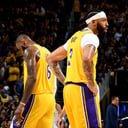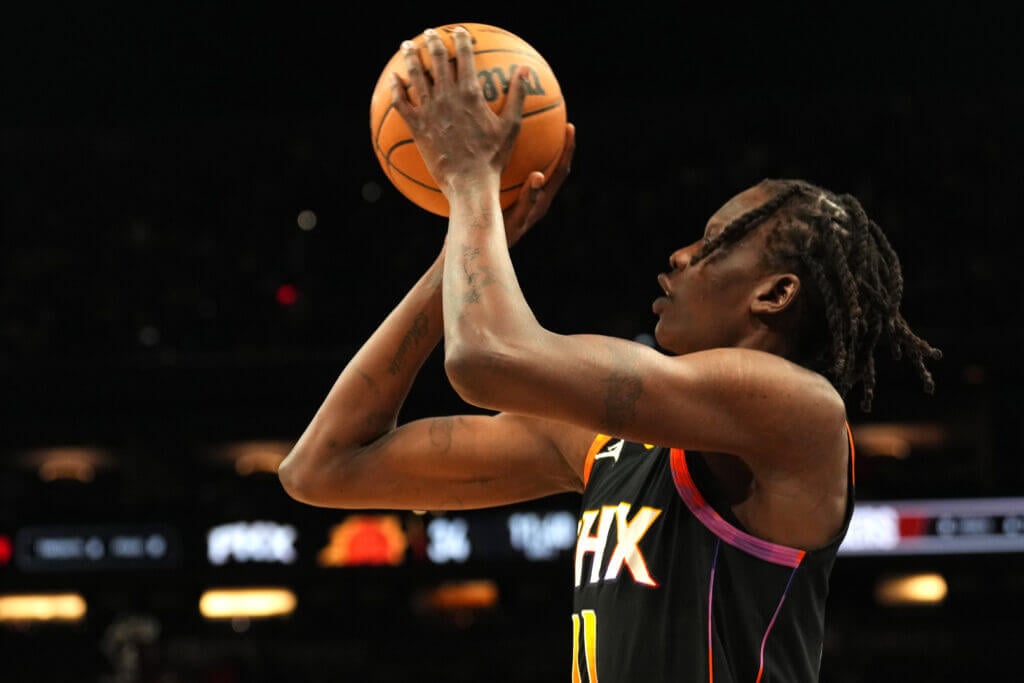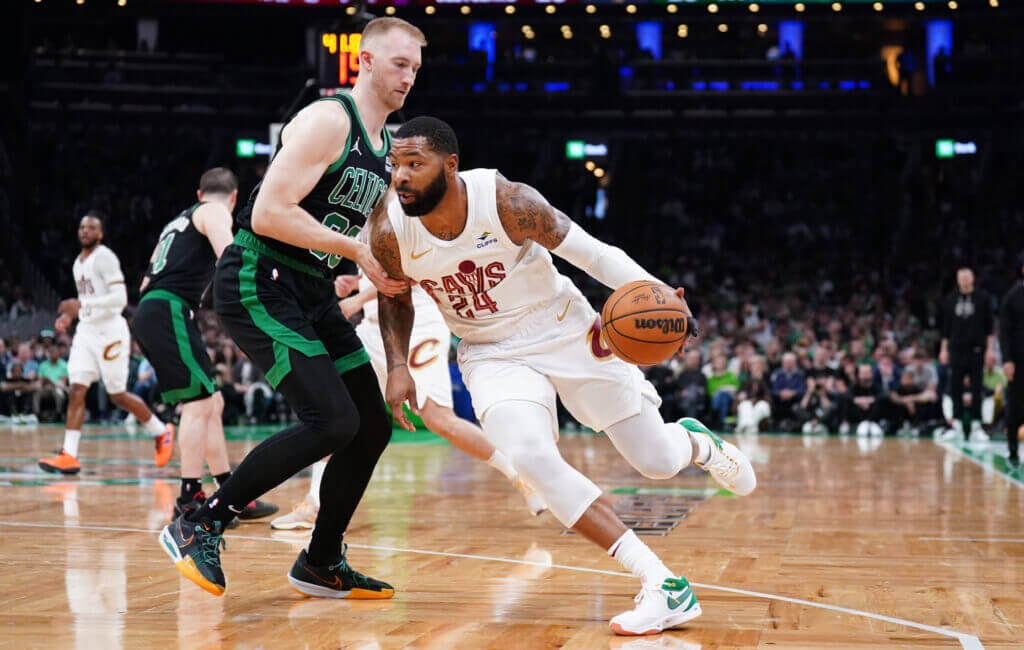NBA free-agency breakdown: Overall Top 25 | Point Guards | Shooting Guards | Small Forwards | Centers
As we continue our survey of the free-agent market, the power forward group offers one generational name who probably isn’t truly available, one player who is already off the market and then a lot of shrugging. Multiple possible starters are available, but choose carefully.
I’ve analyzed every plausible free-agent power forward here. Note the word plausible — Dāvis Bertāns and P.J. Tucker aren’t giving up their eight-figure player options, for instance, and the Portland Trail Blazers aren’t cutting loose non-guaranteed Toumani Camara or Jabari Walker. As for the non-guaranteed deal of Utah’s Lauri Markkanen, I think it’s safe to say the Jazz will pick up that guarantee.
Advertisement
Here’s how my BORD$ formula rates the value of all the likely options at power forward this offseason.
Tier I: Max and near-max guys
1. LeBron James, Los Angeles Lakers (player option): $56,411,512
In yet another small testament to his greatness, LeBron James turns 40 later this year and still projects as the most valuable free agent in the league by BORD$. He also still rates as valuable enough that a max contract would underpay him in the first season of the deal.
For James to return to the Lakers, he essentially has two options. The first is to opt out in late June and sign a new three-year deal as a free agent in July, which could be for a maximum of three years and $160 million based on current cap guidance. The other option is to opt in to his deal for $51.4 million next season then sign an extension once he is eligible in late August; that could add two additional years for a total of three and make him $162 million over the three seasons.
Why would he take less money with the former option? Because that one can come with a no-trade clause, which would either guarantee he stays a Laker (and presumably retires as one) or controls his next destination. James could also sign with another team for a maximum of three years and an estimated $155 million, but that seems highly unlikely.

GO DEEPER
LeBron James, Anthony Davis and the Lakers’ (real) draft decisions that loom large
2. Pascal Siakam, Indiana: $38,497,200
Siakam has already agreed to a four-year, $189 million max extension with the Pacers with no team or player option. The contract would start at an estimated $42.3 million for 2024-25, which isn’t too far off this valuation.
Given what Indiana gave up to acquire him, there was presumably an understanding of what might be required to retain Siakam when the trade with Toronto went down. Siakam is 30, so the back end of this deal could get rough, but the projected 10 percent cap raises in the following three seasons should take away some of the sting. Also, note that the deal is for four years and not five, which Siakam was eligible for; the value on the four-year deal, however, slightly exceeds what any other team could have offered him.
Advertisement
Tier II: More than midlevel exception, less than max
3. Tobias Harris, Philadelphia: $26,251,672
I know this number will shock people after his no-show in the playoffs, but Harris was actually good for most of the season, and his past three seasons have been pretty consistent at a plus-starter level. He turns 32 in the offseason, so his next deal is likely to be a short one, but for teams in the market for a starting four, there just aren’t a lot of options this summer. Don’t be surprised if he gets something close to this dollar figure annually on either a two- or three-year deal.
4. Sam Hauser, Boston (team option): $20,692,431
I didn’t list Hauser in my top-25 overall free agents given the unlikelihood of Boston declining his team option, which is for a mere $2.1 million. In this space, however, it seems appropriate to point to the possibility of the Celtics declining the option and signing him to a new deal right away to smooth out the dollars over the life of his next deal.
Working against that possibility is the fact that Boston is already pushing into the second apron and facing a large luxury-tax bill. Because of that, the Celtics might just prefer to ink a normal extension with Hauser — he’s eligible for one worth up to four years and $78 million as of July 9 — and then deal with whatever cap issues come up in 2025-26 and later as they arise.

GO DEEPER
Hollinger: Celtics are built to thrive in new cap era ... at least for a little while
5. Kyle Anderson, Minnesota: $18,072,132
As a card-carrying Slo Mo fan (we signed him to a four-year offer sheet for the then-full midlevel exception amount of $37 million when I worked for the Grizzlies), I can’t say I’m surprised that BORD$ ranks him this highly. While his lack of shooting compromises spacing, especially in lineups without a stretch big, Anderson can make up for it with his creation for others; his 9.3 dimes per 100 possessions this season was pretty impressive for a tertiary option, and he handles the ball well enough to steal minutes at the point.
More importantly, Anderson is one of the game’s most underrated defensive players, with fast hands and cross-positional switchability at 6-foot-9. He was by far Minnesota’s most effective defender on Luka Dončić in the Western Conference finals.
Advertisement
On the flip side, he turns 31 over the summer, and you can time his 3-point release with a sundial. Minnesota’s luxury-tax situation will make it difficult to bring him back. But if a rival team inks him to a shorter deal for non-taxpayer midlevel exception money, Anderson should return positive value. Fun fact: If he does sign again for the non-taxpayer midlevel exception, it would be his third such contract, accounting for every season since his rookie deal ended.
6. Obi Toppin, Indiana (restricted): $16,028,538
Toppin was awesome in the playoffs, with his blazing speed a perfect complement to Indiana’s up-tempo style. The complication is that the Pacers just maxed out the guy starting ahead of him (see Siakam, above); can they really afford to pay Toppin too? He’s due for a big raise from the $6.8 million he made in 2023-24, but the Pacers can only go up to about $14 million before they cross into the luxury tax; historically, this has been a no-go zone for the Indiana franchise.
The other piece of this is that the Pacers drafted a power forward in the lottery a year ago. Jarace Walker hardly played last season, but if Indiana sees him as a future piece, a Siakam-Toppin duo would keep him blocked for years. Thus, keep an eye on him: If the Pacers move Walker by draft night, it’s a good sign they’re fixing to keep Toppin.
If not, the Pacers might be vulnerable to offer sheet predators. At any price above the non-taxpayer midlevel exception, Indiana would have to think really hard before matching. However, that dilemma cuts both ways: Toppin may not fit nearly as well on another roster as he does with the Pacers.
7. Miles Bridges, Charlotte: $15,718,150
There are significant off-court reasons to scotch the idea of Bridges, and teams will have to weigh that. In terms of on-court impact, Bridges’ BORD$ figure might come in a bit lower than some expect for an athletic scorer who is 26. He’s been a spotty shooter (34.9 percent from 3 in 2023-24, 34.7 percent career), his defense was somewhere between “disappointing” and “awful” much of the season, and he doesn’t draw many fouls or create a lot of chances for teammates.
What he does provide, in bunches, is scoring, averaging 21.0 points per game in 2023-24 while shooting 55 percent for his career on shots inside the arc. Given the dearth of combo forwards on the market, the basketball case for him as a sixth man is pretty solid.
Advertisement
If the market shuns him and he accepts a minimum deal, it would be the second straight season a 20-point scorer for the Hornets ended up playing for the minimum a year later; Kelly Oubre Jr. settled for the same in Philadelphia a year ago.
Tier III: Midlevel exception guys
8. Jonathan Isaac, Orlando (non-guaranteed): $14,946,079
Isaac has a non-guaranteed deal for $17.4 million in 2024-25, plus a $2.6 million incentive for playing 70 regular-season games. The Magic already probably have more cap room than they can use, but if they need a little extra to rope in a star player, one move would be to waive Isaac and re-sign him at a lower number.
This all falls under the category of “unlikely things we probably needn’t worry about,” but it’s an interesting wrinkle to consider if, say, Paul George suddenly develops an interest in citrus fruit and theme parks.
9. Patrick Williams, Chicago (restricted): $12,002,445
Williams has mostly been a disappointment since the Bulls made him the fourth pick in the 2020 draft, but the basic rule of thumb in Chicago is to assume it will re-sign or extend everybody. That could be at least somewhat in doubt this time around, however, as the Bulls just traded for Josh Giddey, who arguably plays the same position. They presumably did so with the idea of extending him after his rookie contract expires next summer.
If the plan is to keep Williams, however, the Bulls likely have just enough wiggle room below the tax line to retain Williams at a number in this range and also get DeMar DeRozan’s signature on a new deal. That task becomes significantly easier if they turn Zach LaVine’s contract into something more digestible.
Tier IV: More than minimum
10. Kenyon Martin Jr., Philadelphia: $7,465,340
Martin only has a $2.1 million cap hold, and the Sixers have full Bird rights on him. Thus, it wouldn’t be shocking to see Philadelphia use up the other projected $59 million of its cap room on other players and then retain Martin on a new deal. He likely isn’t worth as much as this valuation shows due to his lack of shooting, but he’s also only 23.
11. Bol Bol, Phoenix: $7,380,353
The year is 2185. We have watches more powerful than today’s supercomputers, space colonies on Mars and 125-year life spans … and basketball fans are still debating whether Bol is any good.
Advertisement
The rail-thin, 7-foot-3, 24-year-old floated in and out of Phoenix’s rotation last season but finished with an 18.7 PER on torrid 70.0 percent true shooting, including 42.3 percent from 3. If he can come anywhere near sustaining that shooting performance, it becomes a lot easier to live with some of his dribble blindness and defensive inattention. The Suns will not have Bird rights on Bol, but I don’t expect his next contract to match this BORD$ valuation.

12. Nicolas Batum, Philadelphia: $7,307,331
The Sixers are planning on using their cap room to sign other players, but Batum’s projected valuation makes him a strong candidate to rejoin the team via the room exception once Philadelphia is done shopping. The 35-year-old is a limited role player now, but he still adds value with his 3-point shooting (39.5 percent last season), team defense and IQ.
13. Precious Achiuwa, New York (restricted): $6,189,752
Achiuwa gave the Knicks some good playoff minutes as a backup five last season when Mitchell Robinson was injured, even though his best position is the four at 6-foot-8 and 225 pounds. Achiuwa still isn’t much of a floor-spacing threat (career 30.7 percent from 3) but chilled on the shot-thirstiness that plagued his early career and had a positive assist-turnover rate for the first time in his career.
Note that New York could make Achiuwa a qualifying offer to make him a restricted free agent, but that offer would be for $6.3 million — right around where BORD$ pegs his value. If the Knicks want to keep him for less, they’d be better off not making the QO.
14. Kevin Love, Miami: $5,265,333
Love turns 36 this offseason, and his iffy defensive mobility makes it tough to slot him into some matchups. On the other hand, he had a 59.7 true shooting percentage despite an off year from 3 and remains an elite rebounder. Miami has some tricky tax issues to resolve that could preclude it from paying Love, but Early Bird rights will allow the Heat to far exceed last year’s $3.8 million salary if they wish.
15. Taurean Prince, Los Angeles Lakers: $4,751,177
The Lakers went to the Prince well far too often last season, but that also serves to show the leaguewide need for floor-spacing forwards with size. L.A. had little alternative.
This offseason, it seems L.A. can retain him without dipping into exception money, which might be important since tax issues could prevent the Lakers from using their midlevel. Prince is eligible for a 20 percent raise from the Lakers as a non-Bird free agent that would take him up to $5.4 million for the coming season, slightly more than his BORD$ value.
Advertisement
16. Oshae Brissett, Boston (player option): $4,225,854
A forgotten back-end rotation player as the Celtics blitzed the league, Brissett has a player option for $2.5 million with Boston that he reportedly will decline. BORD$ values him higher, but the same was true a year ago when the market only delivered a one-plus-one minimum deal. It’s not clear how he’d do much better this summer after playing only 630 minutes in Boston, although opting out and re-upping for another one-plus-one with the Celtics would save them a tiny bit of luxury tax.

GO DEEPER
Celtics GM Brad Stevens on NBA Draft, Kristaps Porziņģis' surgery and more
17. Trendon Watford, Brooklyn (restricted): $3,757,897
He’s not exactly a household name, but Watford played 63 games for Brooklyn last year and posted a 15.7 PER, shooting 39.7 percent on his rare 3-point attempts. He likely needs to bomb away more willingly to stamp himself as a rotation four, but the 23-year-old is a good value guy for teams to target if the Nets’ potential luxury-tax issues get in the way of a return.
18. Jae’Sean Tate, Houston (team option): $3,664,764
Tate is listed here because he has a team option for $7.6 million. However, given that the Rockets are in relatively good shape cap-wise and have two other non-guaranteed contracts for lesser players who make more money, it seems unlikely Tate would become a cap casualty. Declining the option to sign him to a different, longer deal feels only slightly more plausible, given that the Rockets want to have some expiring money on hand for trades.
Tier V: Minimums
19. Vlatko Čančar, Denver (team option)
Čančar is listed here because Denver seems likely to decline his team option then re-sign him to a one-year veteran minimum deal, which would save the Nuggets roughly a million in salary and luxury tax without impacting Čančar’s wallet at all. It also might possibly make the difference between being over or under the second apron. Čančar missed all of last season with a torn ACL, but if the Nuggets bothered to keep him on the roster all season, he’s presumably still in their plans.
20. Doug McDermott, Indiana
McDermott is 32 and highly cookable at the defensive end. However, he’s also a career 41.0 percent shooter from 3, which is likely going to get him invited to join somebody’s roster on a minimum deal this summer.
21. Robert Covington, Philadelphia
Covington fell out of favor with the LA Clippers and was injured with Philadelphia, but the 33-year-old has had strong impact stats everywhere he’s been. Given that he can likely be brought back on a minimum deal after the Sixers use their cap space, he might not need to roam far this summer.
22. Marcus Morris, Cleveland
He’ll be 35 when camp opens, and his PER slumped to just 9.9 with Philadelphia and Cleveland last season, but Morris also performed respectably in important playoff minutes when the Cavs’ injuries decimated their roster. He should be in demand as a fourth or fifth frontcourt player.

23. Jae Crowder, Milwaukee
Crowder turns 34 this summer, and his production really dropped off this past season, dipping to just 11.5 percent usage and a mere 7.7 percent rebound rate. He played over 23 minutes a game for Milwaukee, but wherever he ends up, it’s hard to imagine him occupying such a large rotation spot unless his play improves.
Advertisement
24. Danilo Gallinari, Milwaukee
Gallinari came back from a torn ACL to post respectable numbers for three different teams. He turns 36 this summer and can barely move on defense, but his ability to shoot 3s and draw fouls around the basket could still help juice a second unit.
25. Lamar Stevens, Memphis
Stevens missed out on a ring when Boston sent him to the Grizzlies at the trade deadline, but he also got a lot more run in Memphis and performed well enough — 14.6 PER, with 23.8 points per 100 — to keep his career alive as a tough, undersized four who can occasionally serve as a junk-ball five.
Tier VI: Signed but vulnerable
26. Bojan Bogdanović, New York (non-guaranteed)
Bogdanović’s minimum valuation by BORD$ may surprise some people, but he is 35, and his level of play quietly fell off quite a bit last season. He has $19 million left on his deal but only $2 million of it is guaranteed if he isn’t waived by June 29.
That, of course, will become immaterial once the reported trade that sends him to Brooklyn for Mikal Bridges is completed, fully guaranteeing his salary in the process. Once upon a time, I had written for the Bogdanović analysis: “It might be in New York’s interests to keep the salary on their books in order to have enough matching salary with non-core players if the right blockbuster trade comes along.” You’ll just have to trust me.
27. Jeff Green, Houston (team option)
Green has a non-guaranteed team option for $9.6 million, with the Rockets basically using his contract as a placeholder that can be used for a trade or waived to create cap space. That means they’re likely to pick up the option and ride out his deal until July 11, when the guarantee hits, before truly making a decision.
With Houston not projecting as a cap room team, it seems his continued presence on the roster depends more on A) whether the Rockets’ transactions push them into the luxury tax and B) whether Houston would prefer to keep him or the equally non-guaranteed Jock Landale. If waived, Green would be an interesting free agent for teams needing another veteran at the back end of the rotation; one suspects the Nuggets might be interested in a reunion.
28. Josh Minott, Minnesota (non-guaranteed)
Minott’s non-guaranteed deal is still cheaper than a veteran’s minimum — important for the Wolves’ tax hit. Equally important is that my spies there think he might be able to push for more regular minutes in his third pro season after playing just 187 total minutes in his first two.
Advertisement
29. Darius Bazley, Utah (non-guaranteed)
The 2019 first-round pick will likely know his fate by July 25, when the Jazz have to guarantee $400,000 for the coming season. He had a strong season in the G League last year, but his contractual future likely depends more on whether the Jazz need his $2.5 million salary slot for other cap room projects this offseason.
30. Eugene Omoruyi, Washington (non-guaranteed)
Omoruyi has a non-guaranteed deal, and the Wizards seem likely to continue looking at other roster upgrades as they rebuild, but he played well enough in 43 games last season that it’s not crazy to think he could make the opening day roster. He also has a final season left of two-way eligibility should he get waived.
31. Aleksej Pokuševski, Charlotte (non-guaranteed)
On a non-guaranteed deal after signing late last season, the 7-foot 22-year-old had career-best numbers in his 18 games as a Hornet. He might still be intriguing enough to be worth keeping around as the Hornets try to rebuild, but if Miles Bridges leaves in free agency, they may need to cut Pokuševski to pursue cap-room signings.
32. JT Thor, Charlotte (team option)
As with Pokuševski above, Thor is likely to be cut loose if the Hornets end up needing the extra cap space; he has a team option for $1.99 million that is also non-guaranteed, meaning the Hornets will likely pick up the option and make the decision on him later. After three very unremarkable years, that decision is likely to be to move on, but Thor is two-way eligible and thus likely to resurface elsewhere.
33. Gui Santos, Golden State (non-guaranteed)
The 55th pick in the 2022 draft, Santos played last year on a rookie-minimum deal that helped reduce the Warriors’ luxury-tax hit. However, the Warriors may need his roster spot for other purposes after he didn’t exactly raze the G League in his 32 games with Santa Cruz. He’d be two-way eligible if Golden State waives him.

34. Mamadi Diakite, New York (non-guaranteed)
Diakite has a non-guaranteed deal for the coming season. Realistically it’s hard to imagine him making the opening day roster as the Knicks are likely to pursue other roster upgrades and might only keep 14 players to dodge the luxury tax.
Tier VII: Everyone else
35. Chuma Okeke, Orlando (restricted)
Okeke has struggled with injuries and shooting consistency, sitting at just 31.8 percent career from 3 and posting a meager 6.9 PER in 47 games for Orlando last season. He’d be a restricted free agent if Orlando makes a qualifying offer, but the Magic seem unlikely to bother.
Advertisement
36. Isaiah Livers, Washington
Washington waived Livers in the final week of the season after he posted a 5.3 PER in 23 games for the Pistons. He’s still two-way eligible and offers a mildly interesting intersection of shooting and leaping ability.
37. Markieff Morris, Dallas
Dallas’ locker-room guy and Kyrie Irving confidant turns 35 in the offseason and hardly plays, but don’t be surprised if he’s back as the Mavs’ 14th man once again.
38. James Johnson, Indiana
Johnson is 37 and only played nine games last season, but the Pacers have kept him in a veteran OG role the past two seasons and have liked what he brings. Plus, he can still kick everyone’s butt in the gym if something breaks out.
39. Anthony Gill, Washington
Believe it or not, this was the respected veteran’s fourth season as a Wizard. It’s not clear if he’ll make it to five given the team’s rebuilding direction, especially given his limited floor spacing (29.2 percent from 3).
40. Thanasis Antetokounmpo, Milwaukee
The additional $2.1 million cap hit on Giannis’ max contract.
41. Luka Šamanić, Utah
Šamanić finished his fourth pro season with an 8.9 PER, shooting 20.3 percent from 3 in 43 games for the Jazz. At this point, his future seems more likely to be overseas.
42. Usman Garuba, Golden State (restricted)
The undersized big man had a good season in Santa Cruz and was added to the Warriors’ roster for six late-season games. He could technically become a restricted free agent, but it seems a more likely path is that he returns on a two-way, which he is eligible to do for one more season.
43. T.J. Warren, Minnesota
He finished last season with the Wolves, and it’s possible the oft-injured forward can come back for one more bite of the apple.
44. Mãozinha Pereira, Memphis
An emergency signing after injuries decimated the Grizzlies’ roster, Pereira has a narrow frame and a limited skill set, but he can run and jump and was one of the best players in the G League last season. At the very least, I’d expect him to get a two-way.
(Top photo of LeBron James: David Jensen / Getty Images)

